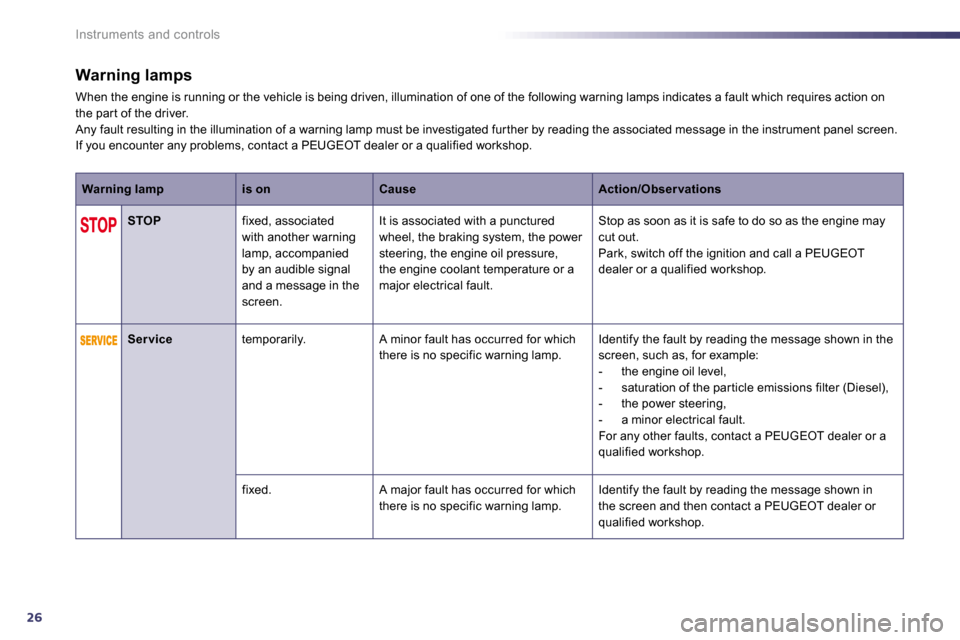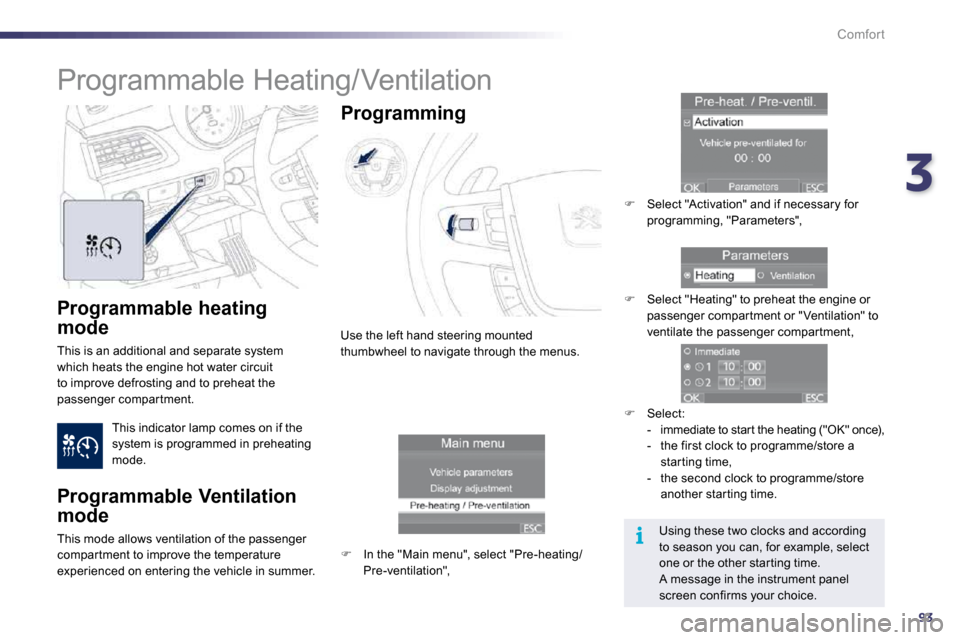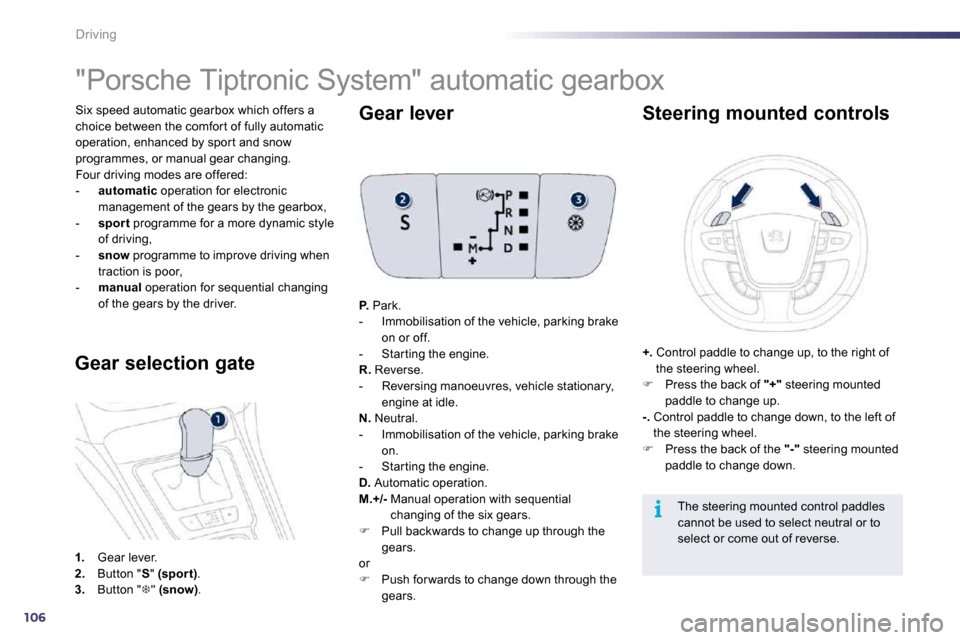2010.5 Peugeot 508 Dag steering wheel
[x] Cancel search: steering wheelPage 7 of 330

10
Familiarisation
9. Fusebox. 10. Front door window demisting/defrosting vent. 11. Windscreen demisting/defrosting vent. 12. Steering lock and star ting with the key. 13. Star ting using the electronic key. 14. Audio equipment steering wheel controls. 15. Wiper/screenwash/trip computer stalk. 16. Central locking and hazard warning buttons. 17. Multifunction screen.
Instruments and controls
1. Cruise control/speed limiter controls. 2. Headlamp height adjustment. 3. Lighting and direction indicator stalk. 4. Instrument panel. 5. Driver's airbag. Horn. 6. Gear lever. 7. 12 V accessory socket USB por t /auxiliary socket. 8. Bonnet release lever.
18. Central adjustable air vents. 19. Passenger's airbag. 20. Side adjustable air vents. 21. Glove box /Passenger's airbag deactivation. 22. Electric parking brake. 23. Central armrest with storage. 24. Upper and lower storage. 25. Audio system. 26. Heating/air conditioning controls.
Page 9 of 330

12
!
Familiarisation
Sitting comfortably
Head restraint adjustment
64
1. Release the adjustment mechanism. 2. Adjust for height and reach. 3. Lock the adjustment mechanism.
Steering wheel adjustment
70
For reasons of safety, these operations must only be carried out with the vehicle stationary.
Heated seats control
0 : off. 1 : low. 2 : medium. 3 : high.
To lower it, press button A . To raise it, guide the head restraint upwards to the desired position. To incline it, swivel the lower par t backwards or for wards.
64
Page 26 of 330

26
Instruments and controls
Warning lamps
When the engine is running or the vehicle is being driven, illumination of one of the following warning lamps indicates a fault which requires action on the par t of the driver. Any fault resulting in the illumination of a warning lamp must be investigated fur ther by reading the as sociated message in the instrument panel screen. If you encounter any problems, contact a PEUGEOT dea ler or a qualified workshop.
Warning lampis onCauseAction/Obser vations
STOP fixed, associated with another warning lamp, accompanied by an audible signal and a message in the screen.
It is associated with a punctured wheel, the braking system, the power steering, the engine oil pressure, the engine coolant temperature or a major electrical fault.
Stop as soon as it is safe to do so as the engine may cut out. Park, switch off the ignition and call a PEUGEOT dealer or a qualified workshop.
Ser vice temporarily. A minor fault has occurred for which there is no specific warning lamp. Identify the fault by reading the message shown in the screen, such as, for example: - the engine oil level, - saturation of the par ticle emissions filter (Diesel), - the power steering, - a minor electrical fault. For any other faults, contact a PEUGEOT dealer or a qualified workshop.
fixed. A major fault has occurred for which there is no specific warning lamp. Identify the fault by reading the message shown in the screen and then contact a PEUGEOT dealer or qualified workshop.
Page 37 of 330

137
i
i
i
Instruments and controls
If dashes are displayed continuously
while driving in place of the digits, contact a PEUGEOT dealer or a qualified workshop.
This function is only displayed from 20 mph (30 km/h).
This value may vary following a change in the style of driving or the relief, resulting in a significant change in the current fuel consumption.
A few definitions…
Range
(miles or km) This indicates the distance which can still be travelled with the fuel remaining in the tank
in relation to the average fuel consumption over the last few miles (kilometres) travelled.
When the range falls below 20 miles (30 km),
dashes are displayed. After filling with at least 5 litres of fuel, the range is recalculated and is displayed when it exceeds 60 miles (100 km).
Current fuel consumption
(mpg or l/100 km or km/l) This is the average fuel consumption during the last few seconds.
Average fuel consumption
(mpg or l/100 km or km/l) This is the average fuel consumption since the last trip computer zero reset.
Average speed
(mph or km/h) This is the average speed calculated since the last trip computer zero reset (ignition on).
Trip reset
� When the trip required is displayed, press the control for more than two seconds or use the left hand thumbwheel of the steering mounted controls. Trips "1" and "2" are independent but their use is identical. For example, trip "1" can be used for daily
figures, and trip "2" for monthly figures.
Page 78 of 330

70
!
i!
Comfort
Automatic day/night model
By means of a sensor, which measures the light from the rear of the vehicle, this system automatically and progressively changes between the day and night uses. It has an anti-dazzle system which darkens the mirror glass: this reduces any driver discomfor t caused by the light beams of following vehicles, the sun...
Adjustable mirror providing a central rear ward view. Equipped with an anti-dazzle system, useful in poor light.
Rear view mirror
Manual day/night model
Adjustment
� Adjust the mirror so that the glass is directed correctly in the "day" position.
Day/night position
� Pull the lever to change to the "night" anti-dazzle position. � Push the lever to change to the normal "day" position.
As a safety precaution, the mirrors must be adjusted to reduce the "blind spot".
In order to ensure optimum visibility during your manoeuvres, the mirror lightens automatically when reverse gear is engaged.
Steering wheel adjustment
� When stationar y , lower the control lever ar yto release the steering wheel adjustment mechanism. � Adjust the height and reach to suit your driving position. � Pull the control lever to lock the steering wheel adjustment mechanism.
As a safety precaution, these operations should only be carried out while the vehicle is stationary.
Page 103 of 330

393
i
Comfort
Programmable heating
mode
This is an additional and separate system which heats the engine hot water circuit to improve defrosting and to preheat the passenger compar tment.
This indicator lamp comes on if the system is programmed in preheating mode.
Use the left hand steering mounted thumbwheel to navigate through the menus.
Programming
� In the "Main menu", select "Pre-heating/Pre-ventilation",
� Select "Activation" and if necessary for programming, "Parameters",
� Select "Heating" to preheat the engine or passenger compar tment or "Ventilation" to ventilate the passenger compar tment,
� Select: - immediate to start the heating ("OK" once), - the first clock to programme/store a star ting time, - the second clock to programme/store another star ting time.
Programmable Heating/Ventilation
Programmable Ventilation
mode
This mode allows ventilation of the passenger compar tment to improve the temperature experienced on entering the vehicle in summer.
Using these two clocks and according to season you can, for example, select one or the other star ting time. A message in the instrument panel screen confirms your choice.
Page 104 of 330

94
i!
i
i
Driving
Starting-switching off the engine
With a manual gearbox , put the gear lever in neutral. With an electronic gear control gearbox , put the gear lever in N . With an automatic gearbox , put the gear lever in P or N .
� Inser t the key in the ignition switch. � Turn the key fully towards the dashboard to position 3 (Star ting) . � When the engine star ts, release the key.
Starting using the key
Switching off using the key
� Immobilise the vehicle. � Turn the key fully towards you to position 1 (Stop) . � Remove the key from the ignition switch.
For Diesel vehicles, in very cold weather the engine will not start until the preheater warning lamp has gone off.
Key left in the ignition
If the key is left in the ignition switch, there is an audible signal on opening the driver's door.
If one of the starting conditions is not met, a reminder message appears in the instrument panel screen. In some circumstances, it is necessary to turn the steering wheel slightly while pressing the "START/STOP" button to assist unlocking of the steering; a message warns you when this is needed.
If the vehicle is not immobilised, the engine will not stop.
� With the electronic key inside the vehicle, press the brake pedal for vehicles with automatic or electronic gear control gearbox, or declutch fully for vehicles with a manual gearbox.
Starting using the
electronic key
� Press the " START/STOP " button.
Switching off using the
electronic key
� Immobilise the vehicle.
� With the electronic key inside the vehicle, press the " START/STOP " button.
The engine stops and the steering column is locked.
Accessory position
With the electronic key inside the vehicle, press the "START/STOP" button, with no action on the pedals, to switch the ignition on or off and so activate accessories.
Page 118 of 330

106
i
Driving
Six speed automatic gearbox which offers a choice between the comfor t of fully automatic operation, enhanced by spor t and snow programmes, or manual gear changing. Four driving modes are offered: - automatic operation for electronic management of the gears by the gearbox, - spor t programme for a more dynamic style
of driving, - snow programme to improve driving when traction is poor, - manual operation for sequential changing of the gears by the driver.
"Porsche Tiptronic System" automatic gearbox
1. Gear lever. 2. Button " S " (spor t) . 3. Button " � " (snow) .
Gear selection gate
Gear lever
P. Park. - Immobilisation of the vehicle, parking brake on or off. - Star ting the engine. R. Reverse. - Reversing manoeuvres, vehicle stationary, engine at idle. N. Neutral. - Immobilisation of the vehicle, parking brake on. - Star ting the engine.
D. Automatic operation. M.+/- Manual operation with sequential changing of the six gears. � Pull backwards to change up through the
gears. or � Push for wards to change down through the gears.
Steering mounted controls
+. Control paddle to change up, to the right of the steering wheel. � Press the back of "+" steering mounted paddle to change up. -. Control paddle to change down, to the left of the steering wheel. � Press the back of the "-" steering mounted paddle to change down.
The steering mounted control paddles cannot be used to select neutral or to
select or come out of reverse.